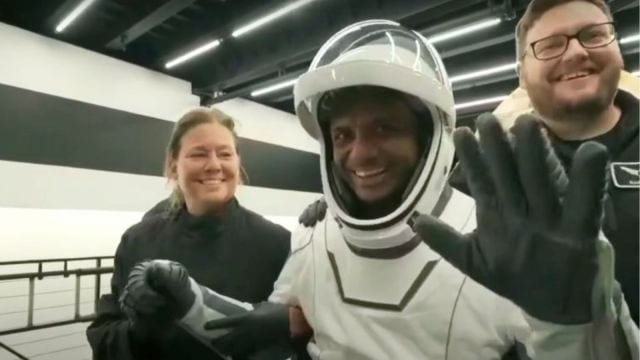Only the second Indian to travel to space, and the first from the country to visit the International Space Station (ISS), Group Captain Shubhanshu Shukla returned to Earth on Tuesday, after a 20-day landmark space journey that prepares the ground for India’s own human spaceflight mission, Gaganyaan.
Assisted by two people, and with a broad smile on his face, Shukla emerged from the space capsule, getting his first feel of Earth in almost three weeks with a few tentative steps.

Exactly 50 minutes earlier, the space capsule, named Grace, carrying Shukla, Peggy Whitson from the US, Slawosz Uznanski-Wisniewski of Poland and Tibor Kapu of Hungary, had splashed down in the cold waters of the Pacific Ocean, off the coast of California.
After detaching from the ISS on Monday afternoon, the spacecraft took about 20 hours to reach Earth. On its way, it made another few rounds of the Earth, giving the astronauts some more opportunities to view it from space. During their 18-day stay on the ISS, the astronauts completed 288 revolutions of the Earth.
After the splashdown, which happened at about 3 pm India time (2.30 am Tuesday in California), the spacecraft was towed by ropes to a waiting ship, before being lifted by cranes and placed on the ship deck. There, one by one, the astronauts were helped out, as they felt the weight of their bodies for the first time since their journey to space on the Axiom-4 mission on June 25.
Whitson was the first to come out, followed by Shukla, and the two others.
After the 20-day stay in microgravity conditions in space, their bodies need time to get accustomed to Earth once again. They required assistance in being pulled out of the space capsule, in standing up on their feet, and in walking.
Story continues below this ad
The first thing they did after coming out of the space capsule was to undergo a health check by a waiting team of doctors on the ship. Shortly thereafter, the astronauts were airlifted by a helicopter to the NASA Space Center in Houston, where they will spend the next few days, resting and recovering, and briefing the Axiom Space, NASA and other teams on the journey, and the experiments that they carried out in space.
Throughout this period, their health parameters will be monitored constantly. Astronauts usually take a few days to about a week to regain normalcy after their return from space.
Congratulating everyone involved in the mission, President Droupadi Murmu said in a post on X: “A hearty welcome to Group Captain Shubhanshu Shukla as he comes back on Earth after his space journey. His role in piloting of Axiom Mission 4 to the International Space Station has created a new milestone for India’s space exploration as well as for international collaboration in science and technology.”
Prime Minister Narendra Modi said Shukla had inspired a billion dreams. “As India’s first astronaut to have visited International Space Station, he has inspired a billion dreams through his dedication, courage and pioneering spirit. It marks another milestone towards our own Human Space Flight Mission – Gaganyaan,” he said on X.
Story continues below this ad
“He has not just touched space, he has lifted India’s aspirations to new heights. His journey to the International Space Station and back is not just a personal milestone; it is a proud stride for India’s growing space ambitions,” Defence Minister Rajnath Singh said on X.
“Bharat today finds an enduring space in the world of Space,” said Science Minister Jitendra Singh, who is also the minister in charge of Space.
Axiom-4 mission was a commercial human spaceflight journey to the ISS, managed by Axiom Space, a private US company, and facilitated by US space agency NASA. The rocket and spacecraft used for the mission came from SpaceX, the world’s largest private space corporation.
The participation of Shukla — a fighter pilot with the Indian Air Force who was selected as one of the four astronauts for Gaganyaan — in the Axiom-4 mission was the result of a strategic partnership forged between NASA and the Indian Space Research Organisation (ISRO) in 2023. Through the Gaganyaan programme, India is hoping to send its first crewed mission to space by 2027.
Story continues below this ad
The Axiom-4 mission provided ISRO an opportunity to gain some first-hand experience in human spaceflight missions ahead of the Gaganyaan launch. The knowledge and experience gained during Shukla’s space journey — 41 years after Rakesh Sharma travelled to space on the then Soviet Union’s Soyuz T-11 spacecraft – would be invaluable for ISRO as well as other astronauts who go on future missions.
ISRO had also designed several experiments for the Axiom-4 mission that would further its space research activities. Shukla carried out those experiments and participated in several others as well.
The Axiom-4 mission not only carried one of the largest number of scientific experiments — 60 experiments representing 31 countries — but it also represented the return of astronauts from three countries, India, Hungary and Poland, back in space after four decades. This is why the mission was themed “Realise the Return”.








